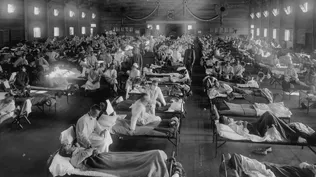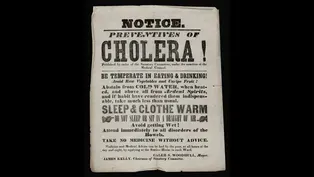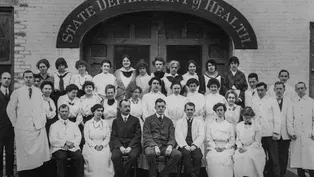
The Origins of Cholera
Clip: Episode 2 | 2m 57sVideo has Closed Captions
Steven Johnson describes the origins of cholera and how interventions stopped the spread.
Steven Johnson describes the origins of cholera and how interventions stopped the spread.

The Origins of Cholera
Clip: Episode 2 | 2m 57sVideo has Closed Captions
Steven Johnson describes the origins of cholera and how interventions stopped the spread.
How to Watch The Invisible Shield
The Invisible Shield is available to stream on pbs.org and the free PBS App, available on iPhone, Apple TV, Android TV, Android smartphones, Amazon Fire TV, Amazon Fire Tablet, Roku, Samsung Smart TV, and Vizio.

The Invisible Shield
Explore the discussion guide for The Invisible Shield, a useful tool for extended learning related to the docuseries. The guide pulls out key themes from the show and presents questions that encourage critical thinking, powerful discussion, and expanded understanding regarding public health.Providing Support for PBS.org
Learn Moreabout PBS online sponsorshipCholera seemed to be related to the question of where you got your water, and no one really came around to his theory until an outbreak erupted literally on his doorstep in the late summer of 1854.
In a poor neighborhood like Soho, most people would get their water from these public wells.
There'd be a pump and people would go with a couple of buckets and they would collect water for the day or for the week.
And it happened there was a very popular pump right across from 40 Broad Street in the heart of Soho.
At some point, the well water became contaminated with the bacterium that causes cholera.
And this central watering hole for the entire neighborhood became a vector of death.
And within a few days, the single most concentrated and terrifying outbreak of cholera in England's history erupted in Soho.
And over the course of the next three or four weeks, 10% of the neighborhood was dead.
With an outbreak that concentrated, John Snow thinks there must be one source of water that is contaminated.
And if he can find that source, maybe he can finally convince the world that his theory about cholera's origins is correct.
Snow steps out into his community and starts knocking on doors, asking people, 'Has anyone died here?
Has anyone gotten sick here?
And where did you get your water?'
But he also relies on public data that had been accumulated by William Farr.
Everywhere he looks, if someone has gotten sick as part of this outbreak, they had some direct connection to the well water at 40 Broad Street.
And based on that information, he starts to build a case for why the pump should be shut down.
And ultimately, Snow decided to represent all of the data that he and Farr had collected as a map.
It was a bird's eye view street map of the neighborhood with a little circle marking the well at 40 Broad Street.
For each death at each address, he put a little black bar corresponding to that death.
Because it was so concentrated, because it was so terrible, It enabled Snow to represent to other people this pattern that explained what was causing the death in the first place.
Snow presented his case to the local Board of Health and the pump handle was removed.
Within a few weeks, the outbreak was over.
It was one of the first cases where an actual intervention had been made by the authorities based on data.
And that led to a whole series of interventions to make communities safer over time.
Cholera and the Modern Public Health System
Video has Closed Captions
How the 1854 cholera outbreak led to the birth of the modern public health system. (1m 12s)
Video has Closed Captions
Data has been an essential public health tool since at least the seventeenth century. (30s)
Providing Support for PBS.org
Learn Moreabout PBS online sponsorship













